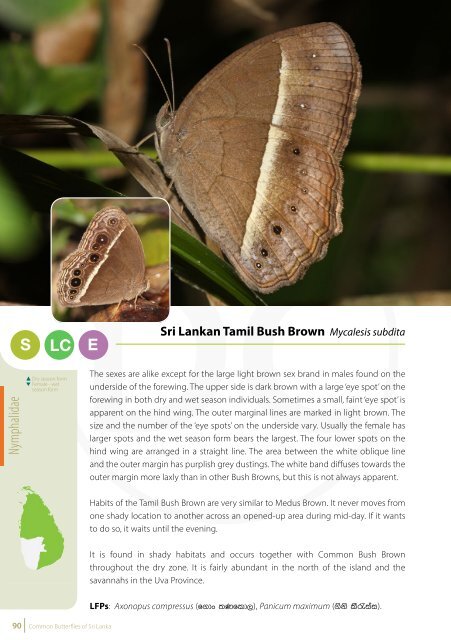Common Butterflies of Sri Lanka
Common Butterflies of Sri Lanka
Common Butterflies of Sri Lanka
Create successful ePaper yourself
Turn your PDF publications into a flip-book with our unique Google optimized e-Paper software.
S<br />
LC<br />
E<br />
<strong>Sri</strong> <strong>Lanka</strong>n Tamil Bush Brown Mycalesis subdita<br />
<strong>Common</strong> Bush Brown Mycalesis perseus<br />
S<br />
LC<br />
Nymphalidae<br />
Dry season form<br />
Female - wet<br />
season form<br />
The sexes are alike except for the large light brown sex brand in males found on the<br />
underside <strong>of</strong> the forewing. The upper side is dark brown with a large ‘eye spot’ on the<br />
forewing in both dry and wet season individuals. Sometimes a small, faint ‘eye spot’ is<br />
apparent on the hind wing. The outer marginal lines are marked in light brown. The<br />
size and the number <strong>of</strong> the ‘eye spots’ on the underside vary. Usually the female has<br />
larger spots and the wet season form bears the largest. The four lower spots on the<br />
hind wing are arranged in a straight line. The area between the white oblique line<br />
and the outer margin has purplish grey dustings. The white band diffuses towards the<br />
outer margin more laxly than in other Bush Browns, but this is not always apparent.<br />
The sexes are alike except for the small black sex brand on the underside <strong>of</strong> the<br />
forewing in males, which is usually concealed by the hind wing. The upper side is dark<br />
brown. It has an ill-defined, variable ‘eye spot’ on the middle <strong>of</strong> the fore wing in its dry<br />
season form, but this feature is absent in its wet season form. The prominence <strong>of</strong> the<br />
‘eye spots’ on its underside is highly variable and the white line encircling the spots<br />
may be absent in some individuals. The four lower spots on the hind wing are placed<br />
in an incurved arc, leaving a larger gap between the wing margin and the spot, in<br />
the middle two. A white oblique band is present across both its wings, and is usually<br />
thinner than that <strong>of</strong> the Dark Brand Bush Brown. Females tend to have broader bands.<br />
Wet season form<br />
Nymphalidae<br />
Habits <strong>of</strong> the Tamil Bush Brown are very similar to Medus Brown. It never moves from<br />
one shady location to another across an opened-up area during mid-day. If it wants<br />
to do so, it waits until the evening.<br />
It is found in shady habitats and occurs together with <strong>Common</strong> Bush Brown<br />
throughout the dry zone. It is fairly abundant in the north <strong>of</strong> the island and the<br />
savannahs in the Uva Province.<br />
LFPs: Axonopus compressus (f.dx ;Kfld,), Panicum maximum (.sks lS/iai).<br />
The habits <strong>of</strong> the <strong>Common</strong> Bush Brown are very similar to those <strong>of</strong> the Tamil Bush<br />
Brown.<br />
This butterfly is commonly found in shady places all over the country, except for in<br />
dense forests. Coconut plantations with thickets are a good habitat for this butterfly.<br />
LFPs: Various grasses including Eleusine indica (ne,;K), Oryza sativa (f.dhï) and<br />
Axonopus compressus (f.dx ;Kfld,).<br />
90 <strong>Common</strong> <strong>Butterflies</strong> <strong>of</strong> <strong>Sri</strong> <strong>Lanka</strong><br />
<strong>Common</strong> <strong>Butterflies</strong> <strong>of</strong> <strong>Sri</strong> <strong>Lanka</strong> 91















